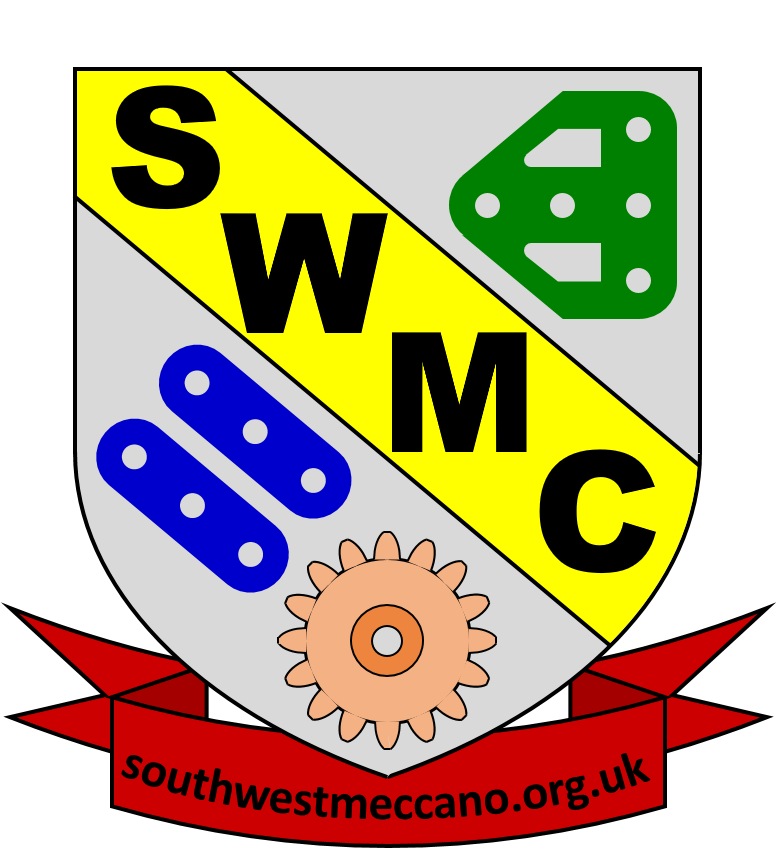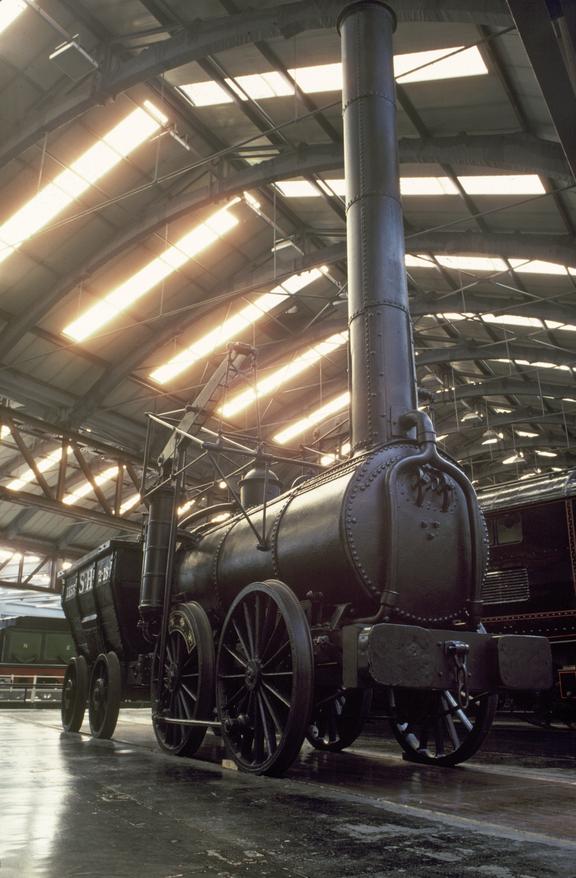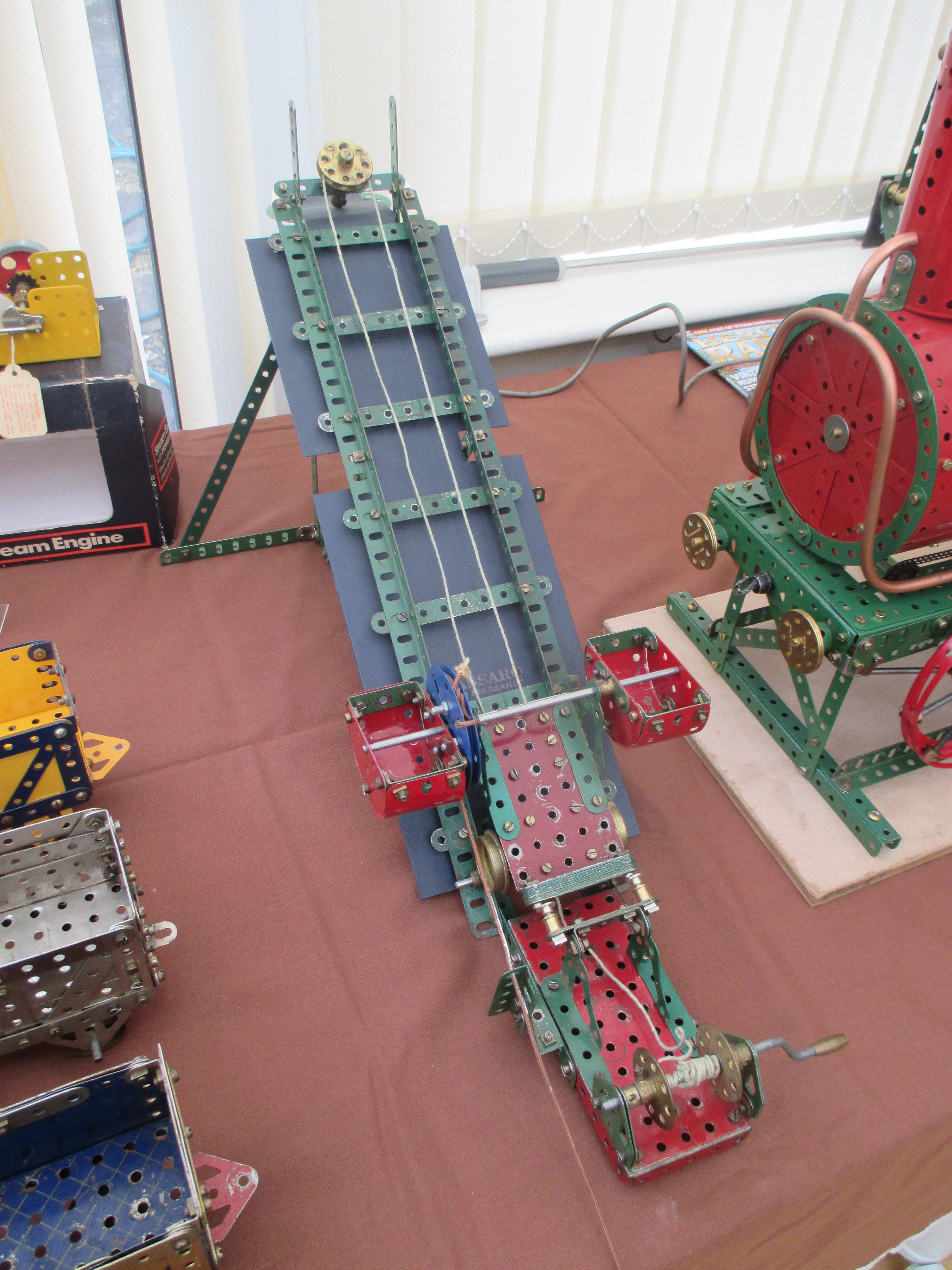2019 January meeting
This meeting was very well attended, with a potential new member and a guest who is interested in integrating computer control into Meccano Models.
Pete Evans displayed a scale model of the 'Agenoria' steam locomotive. The original was one of the world's first steam locomotives, built in 1829 to haul coal wagons at Staffordshire's Shutt End Colliery. A replica of it resides in the York National Railway Museum. The beam and rod mechanism is thought to be known as a 'grasshopper action'.
See this in action on YouTube.
Sam Medworth brought along a coal slag tippler built for the Radstock Museum display. This machine used to take spoil from coal mining and dump it into piles, characterised by their appearance as a black volcano. The model can be operated by visitors simply by turning the winding handle to draw the slag buckets up the inclined track. Sam also brought along three coal wagons in different liveries, which will be added to the four being made by Phillip Bond, also for the Radstock exhibition.
Barry Winslow displayed a beautifully clean Mamod steam engine, still with its original box, produced between 1965 and 1979. This particular example will not be 'hot run' by steam, but maybe by compressed air in the future, to keep it pristine. When they do run, they run very fast as can be seen in this Youtube video (about 3 minutes 50 seconds in).
Also on display was a recreated No. 9 set, 100% complete, comprising superb condition parts. The original box was bought at auction but is currently missing a key for the lock, so if anyone has a potential candidate, please do get in touch. The box did however come with some original dust cards, now put to use for mounting the set.
John Day showed his Orrery, built from a mid 50's plan he thinks. The sun in particular was well represented by the use of a spikey dog ball, and the earth by a mini globe; brilliant! Building a set 10 Orrery from a Michael Whiting plan is a future possibility.
Continuing with the Radstock exhibition theme, he also brought a 'ship coaler' used for transferring coal between ship and shore quickly to minimise the time in port. The model had a few rigging issues initially, but sorted once the grab - plus lead weights - were added. This model is intended to be operated by museum visitors.
Accompanying the coaler was a coal sifter machine and coal cutter. The sifter funnelled coal from a hopper onto an oscillating bed which graded the coal by size. The model coal cutter operated well, and demonstrated how the rotating cutter moved horizontally through the bottom of a coal seam creating a deep channel. The coal seam above the channel would collapse, ready to be broken up and removed.
The USS Missouri by Steve Briancourt was again on display, still a work in progress but this time showing an almost complete port side hull. In particular, a lot of work had gone into the difficult aft hull cladding surrounding the propeller shafts, which now includes realistic 4 and 5 bladed propellers. These were fashioned from the centre conical portions of some old tin wheels, cut/bent into shape and painted a dull bronze. Topside, the three principal gun turrets now had a proper cladding. Next to come will be the decking. Now that Steve has retired, he is keen to finish the model ready for some of the other exhibition opportunities.
Alan Perry brought two items. One was a less common 'set B' in its box, but in very good condition. This was from 1982 of French origin, and included some fabric parts. There were also sets A and C of the same series. The second item - a model of an open truck - had more of a personal connection. One of the actual trucks was owned by his father between 1947 and 1965. Alan spent a lot of his youth working with his father operating the truck. It was used to haul coal from Marlborough station in Wiltshire to the nearby college, which used 1200 tons of coal each year. Alan mentioned that the smaller coal pieces would fall out of the corners of the truck sidewalls, so they used sacking to prevent this. For the day, the real coal in the model had no chance of escaping. The truck was later sold on to a furniture removal company, and is now a crumbling ruin somewhere.
Kevin Harris demonstrated some nimble finger work by producing a single dice with faces made from 3 hole by 3 hole flanged plates. Internally there were no brass parts, with the faces all held by standard nuts and bolts, so access to the nuts is solely via the remaining clear holes. The faces of the dice included numbers represented by appropriately placed bolt heads. This was from a design seen on Ralph & Sue's website.
Richard Smith brought a model of a tractor, at quite a small scale such that all the functioning mechanisms were squeezed into a very tight volume. Functions comprised forward and reverse driving, steering and differential braking. It had originally intended to be a Fergusson tractor, but the internal complexity meant it deviated from a true scale model. As usual, the quality of the repainting was superb.
Neil Bedford brought two small racing cars built from parts of the blue/gold era. The first was a Morgan 3 wheeler, fitted with a modern Meccano 'cube' motor powered by 4AA batteries. The motor speed was reduced using a worm gear drive. Included were front suspension and steering, though he admitted the steering could do with some improvements.
The second model was based loosely on a BRM powered by 3AA batteries, but geared such that it ran very fast (unfortunately not demonstrated). It too had working steering and rear suspension. Both models were made largely from refurbished parts, painted in a shade close to the original Meccano gold. The blue hatched plates were original, brought to a nice finish by a little polish.
Chris Bates demonstrated a working tram, powered by an overhead cable and earthed via the wheels on the track. The seats at this scale needed to be 4 hole by 3 hole, which was achieved using three 2" strips which have a 5th centre hole for mounting them. Fortuitously, the end profile of the ganged strips acted as a detent for the seat backrests which could be flipped from facing the front to facing the rear of the tram. This is actually how tram seats were rearranged for the reverse journey. Chris highlighted how he achieved the awkward curvature of the 'winding' effect of the stairs.
See a video of this in action on YouTube.
Another model which Chris has made for the Radstock Museum is of a mineshaft lift which was too large to bring to the meeting. He played a video of this working on his laptop, to demonstrate how the museum visitors will operate it.
Ian Jeeves also made and demonstrated a model for the Radstock exhibition. This was a 1712 Newcomen steam engine of a type which pumped water out of mines. The real thing used steam pressure to push the piston out, but then condensed the steam causing a partial vacuum, which drew the piston back in, providing the action to draw the mine water up.
You can see a short video of this on YouTube.
Also attending the meeting were regular members Andrew Jefferis and David Northcott and new member Dave Boorman who we welcome to the club. Another potential member visited all the way from Hereford to see what we get up to, so we hope he wasn't disappointed! Lastly, guest Andy Pearson from the Thornbury U3A Computer Club examined possibilities for including computer control into Meccano models. The USS Missouri is a good candidate for this as there are many functions to continually demonstrate during exhibitions which is quite demanding on time.
Finally, there was the presentation of the Malcolm Hanson cup to Richard Smith, who won the award for his superb model of the steam loco, the 'Duchess of Devonshire' with two of its carriages (painted in different liveries on each side). Congratulations Richard. See 2018 Malcolm Hanson Trophy page.
Many thanks go to Dianne for providing a splendid array of food and drinks. The afternoon was enjoyed by all.




























